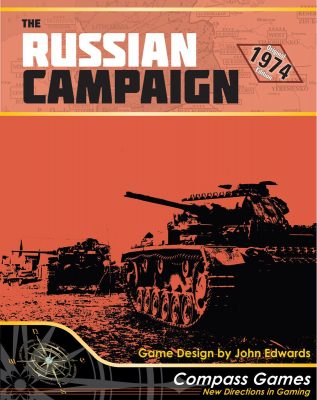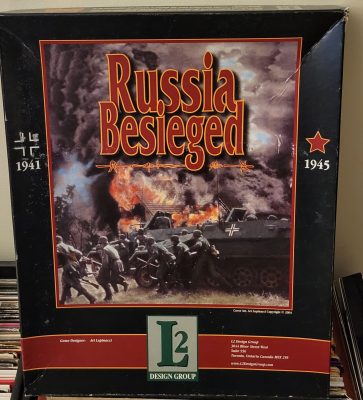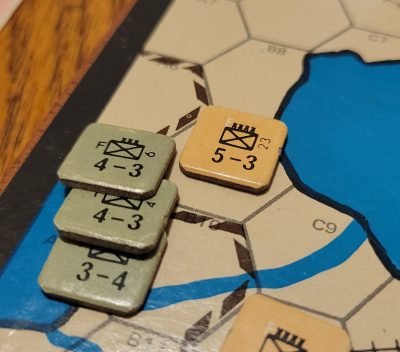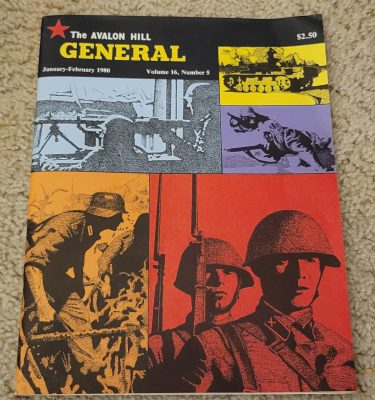The Russian Campaign: The Classic that Refuses to Die
By David Garvin
Way back in 1974, Australian John Edwards released a game that remains popular to this very day. That game? The Russian Campaign. It was eventually picked up by Avalon Hill and later the L2 Design Group, worked over by such game designers as Don Greenwood, Richard Hamblen and Tom Gregario.
And as of early January, 2023, an incredible 5th edition is up for P500 at GMT Games. The hobby is filled with several games depicting the war on the Eastern Front, from the monsters “Fire in the East” by the Game Designers’ Workshop (GDW) and “Guderian’s Blitzkrieg II“, to more simple games such as “Blitzkrieg to Moscow II“.
There are of course games that cover certain aspects of the war, such as “Death Ride Kursk: Grossdeutschland“, “Stalingrad ’42” and “Panzer Battles: 11th Panzer on the Chir River“. These games all range from the Strategic to the Tactical. Yet among them all, one stands head and shoulders above the rest: the Russian Campaign

The first edition of The Russian Campaign (TRC) was issued back in the mid-1970s by Australian John Edwards in a company named after himself: JEDKO. The game quickly caught the attention of Gaming Giant, Avalon Hill, and the rules were reworked and the game repackaged not once, but twice.
The game was a smash hit and won the prestigious Charles S Roberts award for Best Strategic Game of 1976. Later editions received nominations, including “Best World War II Boardgame of 2003” and “Best Wargame Graphics of 2003”. The game was so popular that a more complex version of the game was released by the L2 Design Group: “Russia Besieged“.

TRC itself isn’t that complex of a game, truth be told. The rules are rather thin: I have a copy of the 2nd edition and the rules are 6 pages, including the introduction and a column and a bit of optional rules. That said, the complexity of the game isn’t in interpreting the rules – they are easily grasped, even by the new player – it is in the execution of the rules and the interaction between the players that adds complexity.
As an example of the simplicity of the rules, every unit has a zone of control (ZOC), and if a moving unit enters an enemy ZOC, that moving unit must stop. That moving unit must either immediately Overrun the in-place unit, or it must attack in the subsequent combat phase.
This may sound simple enough – and it is – but the implications can be devastating when an attack fails and then because a unit starting in a ZOC in the 2nd Movement Phase cannot leave, it is forced to attack in the 2nd combat phase, even if the odds are suicidal! A common tactic to exploit this rule is to surround a defender and attack at mediocre odds, hoping for a “C” result, or contact. Then in the subsequent turn, the erstwhile defenders are forced to attack at terrible odds!

The setup of the main “Barbarossa” scenario is fairly simple; however, there is enough variation that over the years, numerous articles have been written on stratagems and counter moves to help dictate the opening moves. In all honesty, it reminds me of the reams of writings on Chess with move and counter-move played out ad infinitum.
As an example, I have a copy of an old issue of “The General” (Volume 16, Number 5) from January 1980. Its opening article, “Tactical Alternatives in 1941: Analysis of Russian Strategy in THE RUSSIAN CAMPAIGN” is a total of 14 pages, or over twice as long as the rules for the game!
How to set up the Finnish Front, involving 4 Axis and 2 Russian units, takes up the first two and a half pages. The article goes on and uses various Russian Fronts as a guide, the author plays out a few action/reaction/counter actions for the first turn! There are numerous articles – too many to list – but they have captivating titles such as “The Viipuri Defense”, “The Road to Berlin”, “The Crimea River Defense”, and even “Turning the Tide – Playing the Russian in Russian Campaign”.

So, the interest has been there since the start and even well into the 21st Century. But why? And why did this lead to a P500 that has over 2,800 purchases as of the time of this writing? There are several other Eastern Front wargames out there, even at this level. I previously discussed War in the East 2, which has a computer engine to manage all the complexity one would want.
Why this game, when it is prone to very ahistorical results? The answer, I believe, is in its simplicity and replayability. The rules – like chess – are not complex at all; however, the implications of how those rules play out in the game can lead to very unique results. The last match I had, as an example, had me playing the Russians and I ended up losing to the Germans in the Autumn of 1941! Stalin was dead and German Panzers were rolling through Red Square!

All this to say: if you are looking for a classic board wargame that isn’t too difficult to learn, but a challenge to master, then look no further. The P 500 promises to be a throwback to the original game by John Edwards, but with years of variants and “What ifs” added. A serious gamer could spend months finding and reading various articles on strategy, tips, and tactics for the game. But the best way would be to set the game up, call over a friend and start rolling the dice. Sure, you may fall victim to the Viipuri Trap, but in the end, all you have to do is set it back up and play again!
David Garvin is an avid hex-and-counter gamer, who counts TRC as one of his first games.

Great review.